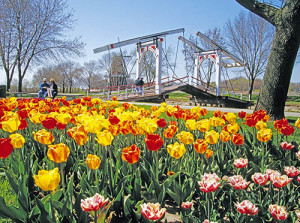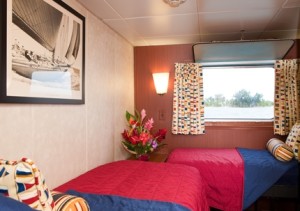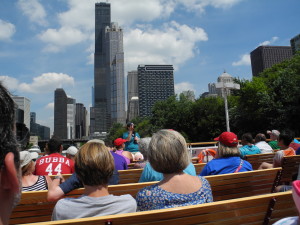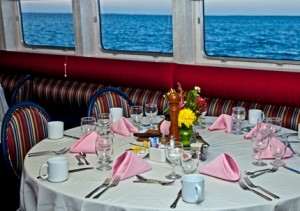
Spring tulips on Windmill Island are a highlight of a stop in Holland, Michigan. Photo by Dennis Cox/WorldViews.
Second in a Series
How can you get from Chicago to Holland without crossing the Atlantic Ocean?
Just book a “Magical Lake Michigan” cruise with Blount Small Ship Adventures, a line that specializes in taking passengers along the rivers, lakes, waterways, and seas of the United States, Canada, Central America, and the Caribbean.
Holland, in fact, is a town on the west coast of Michigan, and it was the first stop after embarking in Chicago, Illinois, aboard Blount’s 88-passenger ship Grande Mariner.
For those unfamiliar with Lake Michigan, it’s one of the five Great Lakes that top several states in the northern (mostly Midwestern) tier of the U.S. and together comprise a fifth of the world’s fresh water supply.
As I wrote in my previous post, I was returning to my roots, having been born in Michigan and spending time vacationing there with my family just about every year of my boyhood.
But I had forgotten just how beautiful “Pure Michigan” — the state’s enticing advertising tagline — can be.
First, though, we needed to get to Chicago, the third largest city in the U.S. and an enticing destination in its own right.
For reasons that seemed to make sense at the time, my wife, Catharine, and I decided to drive from upstate New York, where we live, to Chicago, which turned out to be 750 miles away. And make the drive in one day.
Leaving at 4 a.m. and fueled by coffee and banana chips (which are delicious, by the way), we left New York, drove the length of Pennsylvania and the width of Ohio and Indiana, before entering Illinois, greeted by Chicago traffic at rush hour.
Our goal was to find the parking garage I had reserved on the lower portion of East North Water Street, which was one too many directions for our GPS, which gave up and left us on our own to guess where to turn. The city was hopping, roads were blocked off for a festival, but somehow we stumbled upon the garage, which was well hidden down a tunnel below East North Water Street and clearly a bargain since few people could actually find it.
Having gained an hour toward the end of Indiana, we remarkably made it in time for dinner on the ship, part of an early-arrival package that about half the 70 passengers took advantage of, allowing us to sleep on board and have a few meals before the rest of our fellow shipmates showed up. They hailed from across the United States, and most had the good sense to fly or take the train.
The Grande Mariner was docked right at Navy Pier, the centerpiece of the Chicago waterfront and a mecca of restaurants, rides (including a giant Ferris wheel), and booths selling tickets for harbor and river cruises.
The next morning we chose the latter, taking a Shoreline Architectural River Cruise down the Chicago River. Highly recommended: You get an hour and a quarter cruise on the river that flows through the center of the city, with a running narrative about the fascinating and extremely varied architecture that makes the Chicago skyline one of the most impressive in the country.
That afternoon we took a long walk along the sandy beaches that stretch for miles north of Navy Pier, packed on a sunny day. If you’ve never been to Chicago, or visited in summer, you might be surprised to learn that the Windy City has the best urban beaches this side of Rio de Janeiro. The water, however, is a bit nippier, which didn’t deter a number of teenagers from taking the plunge.
By nightfall, it was time to head to Holland (Michigan), across the lake. As we left Navy Pier, heading out across the lake with the Chicago skyline brilliantly lit up, fireworks going off somewhere in northern Indiana, and a bright moon waxing overhead, many of us agreed that that memorable scene alone was worth the price of the cruise.
As was the serene passage early the following morning through narrow five-mile-long Lake Macatawa, which leads to the town of Holland. As we glided along, we passed summer homes — which ranged from modest cottages to gaudy mansions — as well as pleasure boats heading out to sea (or so Lake Michigan seemed — it’s 120 miles wide and 300 miles long, the world’s fifth largest lake).
After docking near the downtown area and having breakfast on the ship — always a hearty meal consisting of both buffet items and family-style platters of eggs, meats, or other dishes brought to the tables — we opted to skip the optional organized tour and explore Holland on our own.
Strolling through the historic district, the site of a good many Victorian-era homes and pretty flower-bedecked parks, we soon came upon the town’s main street, lined with attractive shops and restaurants.
A helpful fellow at the visitor’s center directed us to Windmill Island, about a mile’s walk away through a park and past a marshy area, where the Hollanders celebrate their Dutch heritage.
Besides a number of old-style Dutch buildings, the big attraction on the island is a huge, genuine windmill that was the last the Dutch government allowed to leave the country. (The Netherlands once had about 8,000 windmills, but many were destroyed during World War II, and the numbers had dwindled to around 1,000.) It was presented to Holland, Michigan, by a member of the Dutch royal family about 50 years ago.
A guided tour took us halfway up the 12-story windmill. The docent explained that it’s very much a working mill, processing grain for making flour that you can buy at the gift shop, and run by a female miller who has been officially certified by the Dutch themselves.
Her job is arduous and physically demanding: hauling sackfuls of grain around, maintaining the mill, and climbing a ladder high up to start the blades when the mill is in operation three days a month.
On the day we were there, the miller was elsewhere, so we got to climb six flights of stairs and wander outside to inspect the blades, much larger and more impressive than when seen from below, and drink in views that included kayakers navigating a nearby canal. That part looked like great fun, but we crossed “miller” off the list of possible second careers.
After leaving Windmill Island and returning to downtown Holland, we took the almost sacrilegious step of having lunch at an Irish pub, where we had the best veggie burgers of our lives. (In fact, it may have been the only good veggie burger of my life.)
The one thing Holland seemed to lack was real Dutch French fries slathered in mayonnaise, one of my favorite foods in the world. But Holland made for a diverting and scenic stop, and when we sailed back out through Lake Macatawa in late afternoon, we passed a beautiful sandy beach at Holland State Park at the intersection with Lake Michigan, crowded with swimmers and sunbathers. I resolved to return for a longer stay someday.
As we sailed north to our next Lake Michigan destination — remote Beaver Island — I was left to ponder: how can one country simultaneously be called Holland and The Netherlands, be occupied by people called the Dutch, and make the world’s best French fries?
But I was diverted by a beautiful sunset, a gin-and-tonic-fueled happy hour on the ship, views of distant dunes along the Michigan shoreline, and a fine dinner on board, followed by an evening on the upper deck watching the stars.
One day out, and I was already hooked.
Next up: A fascinating stop on Beaver Island.
Readers: You can subscribe to my blog and get notification of every post by simply typing in your email address and clicking on the blue Subscribe button or downloading my free report, How to Ride the Coming Wave of Boomers. Thanks!















Leave a Reply